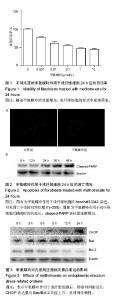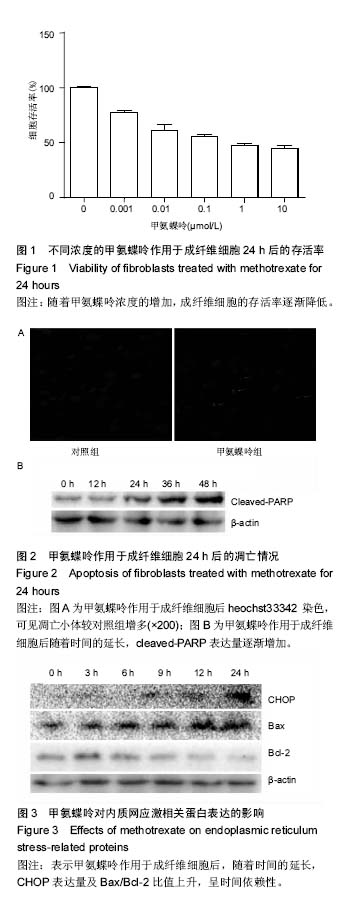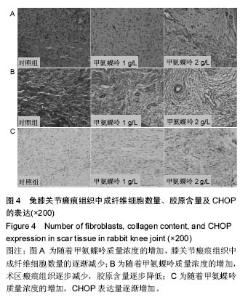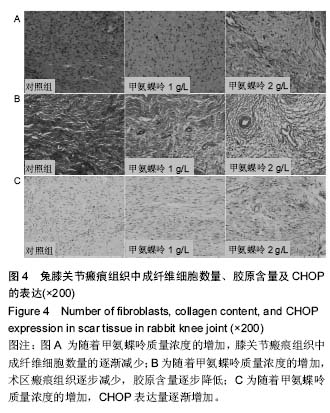| [1] Jingcheng W, Lianqi Y, Yu S, et al. A Comparative Study of the Preventive Effects of Mitomycin C and Chitosan on Intraarticular Adhesion after Knee Surgery in Rabbits. Cell Biochemistry and Biophysics. 2012; 62(1): 101-105.
[2] Mounasamy V,Beizile E,Moskal J,et al.Stiffness following total knee arthroplasty: evaluation and treatment. European Journal of Orthopaedic Surgery & Traumatology.2008;18(2):165-171.
[3] Eakin CL. Knee arthrofibrosis: prevention and management of a potentially devastating condition. Phys Sportsmed.2001;29(3):31-42.
[4] 关丽英,许彩民,潘华珍.内质网应激介导的细胞凋亡[J].生物化学与生物物理进展, 2007,34(11):1136-1141.
[5] Chen H, Yang H, Pan L, et al. The molecular mechanisms of XBP-1 gene silencing on IRE1alpha- TRAF2-ASK1-JNK pathways in oral squamous cell carcinoma under endoplasmic reticulum stress. Biomed Pharmacother. 2016;77:108-113.
[6] Hassan M, Selimovic D, Hannig M, et al. Endoplasmic reticulum stress-mediated pathways to both apoptosis and autophagy: Significance for melanoma treatment. World J Exp Med. 2015;5(4):206-217.
[7] Mahdi AA, Rizvi SH, Parveen A. Role of Endoplasmic Reticulum Stress and Unfolded Protein Responses in Health and Diseases. Indian J Clin Biochem. 2016; 31(2):127-137.
[8] 杨延砚,陈亚平.膝关节粘连的基础研究及治疗进展[J]. 中国康复医学杂志,2006,21(5):472-474.
[9] Neves C, Jorge R, Barcelos A.The network of methotrexate toxicity. Acta Reumatol Port. 2009;34(1): 11-34.
[10] Aly E, Ebrahim A. Apoptosis and electroretinogram after intravitreal injection of methotrexate in an experimental rabbit model. Gen Physiol Biophys. 2016;35(2):231-236.
[11] Paul M,Hemshekhar M,Thushara RM, et al. Methotrexate Promotes Platelet Apoptosis via JNK-Mediated Mitochondrial Damage: Alleviation by N-Acetylcysteine and N-Acetylcysteine Amide. PLoS One.2015;10(6):e127558.
[12] 刘巧红,沈凌汛,滕云,等.甲氨蝶呤对类风湿关节炎滑膜细胞增生及细胞周期的影响[J]. 中国现代医学杂志, 2004, 14(4):223-226.
[13] 曾润铭,金大地,邹育才,等.甲氨蝶呤对类风湿关节炎成纤维样滑膜细胞表达RANKL的影响[J]. 中华风湿病学杂志, 2005,9(9):530-533.
[14] Millett PJ, Williams RR, Wickiewicz TL.Open debridement and soft tissue release as a salvage procedure for the severely arthrofibrotic knee.Am J Sports Med.1999;27(5):552-561.
[15] Brunelli G,Longinotti C,Bertazzo C,et al.Adhesion reduction after knee surgery in a rabbit model by Hyaloglide, a hyaluronan derivative gel.J Orthop Res. 2005;23(6):1377-1382.
[16] 梁远,颜连启.孙钰,等.羟基喜树碱对兔膝关节粘连中成纤维细胞的影响研究[J]. 中华创伤骨科杂志,2015,17(2): 156-159.
[17] Yan L, Sun Y, Wang J, et al. The effect of mitomycin C in reducing intraarticular adhesion after knee surgery in rabbits. Eur J Pharmacol.2010;643(1):1-5.
[18] Kuznetsov JN, Leclerc GJ, Leclerc GM, et al.AMPK and Akt determine apoptotic cell death following perturbations of one-carbon metabolism by regulating ER stress in acute lymphoblastic leukemia. Mol Cancer Ther.2011;10(3):437-447.
[19] Kastratovic T, Arsenijevic S, Matovic Z, et al. Methotrexate and myotrexate induce apoptosis in human myoma fibroblasts (THES cell line) via mitochondrial pathway. Acta Pol Pharm.2015;72(3): 455-464.
[20] Mukherjee S, Ghosh S, Choudhury S, et al. Pomegranate reverses methotrexate-induced oxidative stress and apoptosis in hepatocytes by modulating Nrf2-NF-kappaB pathways. J Nutr Biochem. 2013;24(12):2040-2050.
[21] Shi K, Wang D, Cao X, et al. Endoplasmic reticulum stress signaling is involved in mitomycin C (MMC)- induced apoptosis in human fibroblasts via PERK pathway. PLoS One.2013;8(3):e59330.
[22] Yin X, Sun H, Yu D, et al. Hydroxycamptothecin induces apoptosis of human tenon's capsule fibroblasts by activating the PERK signaling pathway. Invest Ophthalmol Vis Sci.2013;54(7):4749-4758.
[23] 杨昕,曹永平,文立成,等.内质网应激对软骨细胞影响的研究进展[J]. 中国矫形外科杂志,2009,17(9):671-673.
[24] Mei Y, Thompson M D, Cohen R A, et al. Endoplasmic Reticulum Stress and Related Pathological Processes. J Pharmacol Biomed Anal.2013;1(2):1000107.
[25] Spitler K M, Webb R C. Endoplasmic reticulum stress contributes to aortic stiffening via proapoptotic and fibrotic signaling mechanisms. Hypertension. 2014; 63(3): e40-e45.
[26] Sano R, Reed JC. ER stress-induced cell death mechanisms. Biochim Biophys Acta. 2013;1833(12): 3460-3470.
[27] Sovolyova N,Healy S,Samali A,et al.Stressed to death - mechanisms of ER stress-induced cell death. Biol Chem.2014;395(1):1-13.
[28] Xiao B, Cui LM, Ma DJ, et al.Endoplasmic reticulum stress in diethylnitrosamine-induced rat liver cancer. Oncol Lett.2014;7(1):23-27.
[29] Lu P, Struijs M C, Mei J, et al. Endoplasmic reticulum stress, unfolded protein response and altered T cell differentiation in necrotizing enterocolitis. PLoS One. 2013;8(10):e78491.
[30] Zhang H, Lv M, Jia J, et al. Expression of the 78 kD glucose-regulated protein is induced by endoplasmic reticulum stress in the development of hepatopulmonary syndrome. Gene. 2014;537(1): 115-119. |



